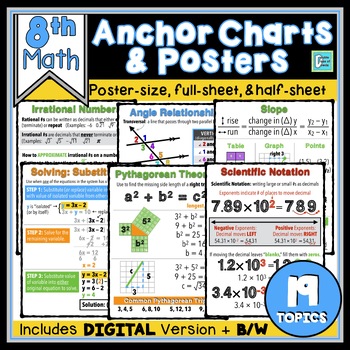8th Grade Math Anchor Charts | Interactive Notebooks, Posters, Print & Digital
- Zip
What educators are saying
Products in this Bundle (19)
showing 1-5 of 19 products
Bonus
Description
Looking for MATH ANCHOR CHARTS to help your students visualize the major topics in your 8th grade math classroom? Hang these on the wall as POSTERS and give students copies for their INTERACTIVE NOTEBOOKS. We keep anchor charts simple and neat so as not to overwhelm students and help keep them focused on essential information.
These are one-page anchor charts for 19 TOPICS that comes in THREE FORMATS including a single page, half sheets (great for interactive notebooks!), and a 2x2 POSTER. The poster will print on 4 sheets of paper which you will need to trim and tape to form one large poster.
⭐ As a SPECIAL BONUS when you buy the bundle you will receive a google slides digital copy of all 19 Anchor Charts to use and post in your online or hybrid classroom.
The Anchor Charts included are:
Congruent & Similar From Dilations & Scale Factor
Solutions for Linear Equations
Solving Systems of Equations using Elimination
Solving Systems of Equations using Substitution
We also have Math Anchor Chart Bundles for:
Click here to FOLLOW US and get 50% off our new products for the first 24 hours.
Connect with us:
♥ Newsletter FREEBIES ♥ YouTube ♥ Facebook ♥ Instagram ♥ Pinterest ♥ Blog ♥
Purchasing this product grants permission for use by one teacher in his or her own classroom. If you intend to share with others, please purchase additional licenses at the discounted rate when you checkout.
We TRULY appreciate your purchase and remind you that leaving feedback earns you TpT credit toward future purchases! If you have any questions, please feel free to contact us.
Thanks so much!
Clint & Alyson Dowda





